Shodasha (16) Sanskar (Samskara) (rite of passage) information (Hinduism) | What is 16 Sanskar in Hindu tradition?
Namaste friends, how are you doing today? Welcome to #BhagavanBhakthi website / blog.
Bhagavan Lord Sri Vishnu (Krishna) (Rama) blessings to you and your family!
In this website / blog, you will always learn about #Hinduism #Sanskrit language.
Also subscribe to my YouTube channel from this link #BhagavanBhakthi to view videos about #Hinduism #Sanskrit language.
Just before going to “Shodasha (16) Sanskar (Samskara) (rite of passage) information (Hinduism) | What is 16 Sanskar in Hindu tradition?“, let us have a brief some brief information.
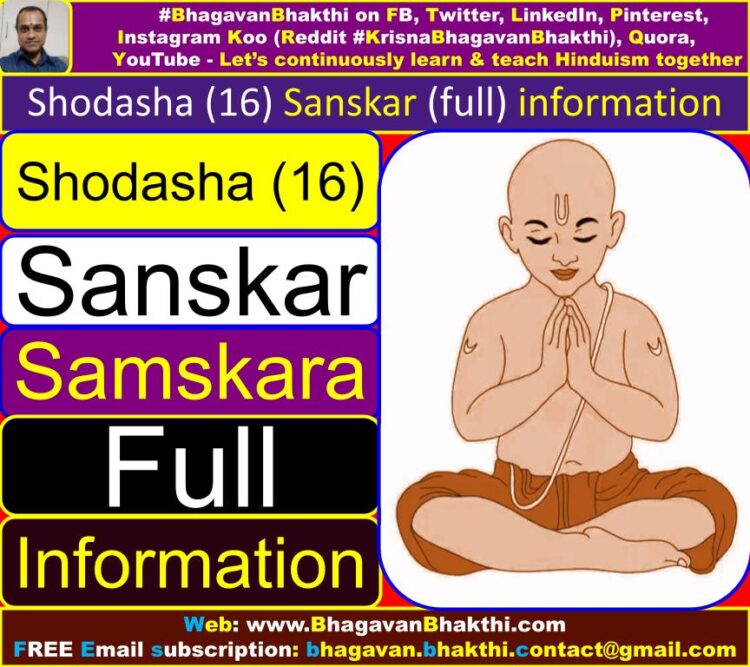
Shodasha Samskara (षोडश संस्कार) is also written and pronounced as ṣōḍaśa sanskāra or ṣōḍaśa sanskār or ṣōḍaśa samskāra or ṣōḍaśa sanskār or Shodash Sanskar or Shodasha Sanskar.
India and Hinduism is so vast in it’s samskaras (Sanskars). Hindus know that what should be done at each age.
At birth what should be done. Later after few years, what should be done. When a child enter the teenage, what should be done.
When the same child when he / she enters his / her youth, what should be done. Then at a later stage when the same child becomes little older, when the marriage should be arranged, etc.
We Hindus are aware of anything and everything since the ‘adi kalam‘ (grand unknown time frame).
We Hindus should be highly proud of our culture and country. Hindus sanskar (Divine rituals) are done based on the explanation given in the Hindu Granthas (Hindu Texts).
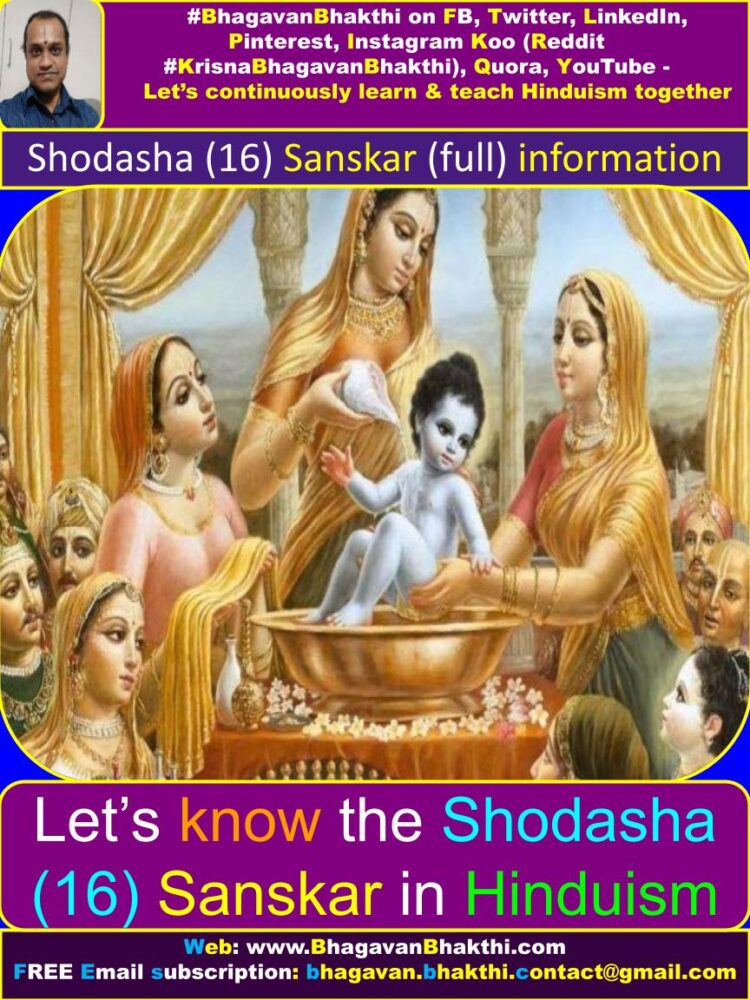
Now, let us let each of such Sanskar one by one:
List of Shodasha (16) Sanskar (Samskara) with information is as given below:
1. Garbhadhanam : (गर्भाधानम्) (garbhādhānaṁ) (conceiving) – Prathamam (First)
This is the first sanskar among all the Shodasa (16) Sanskar.
This is practiced on the first night of the marriage for the newly married couple in which traditional offering are offered through Lord Sri Agni Deva (Aahutis are offered by chanting Vaidika Mantras).
It also involves chanting some special mantras by laying a hand on the bride’s forehead.
Garbhadaana purifies the couple’s ātma / soul and body thereby ensuring to conceive a pure and healthy baby.

2. Pumsavanam : (पुंसवनम्) (pumsavanam) – Dvitiyam (Second) – (To get brave child & healthy child)
This is a Sanskar for having a healthy & brave child. This is the second line of sanskar practiced four months after conceiving for having a baby.
Pumsavana helps one to have healthy and brave child.
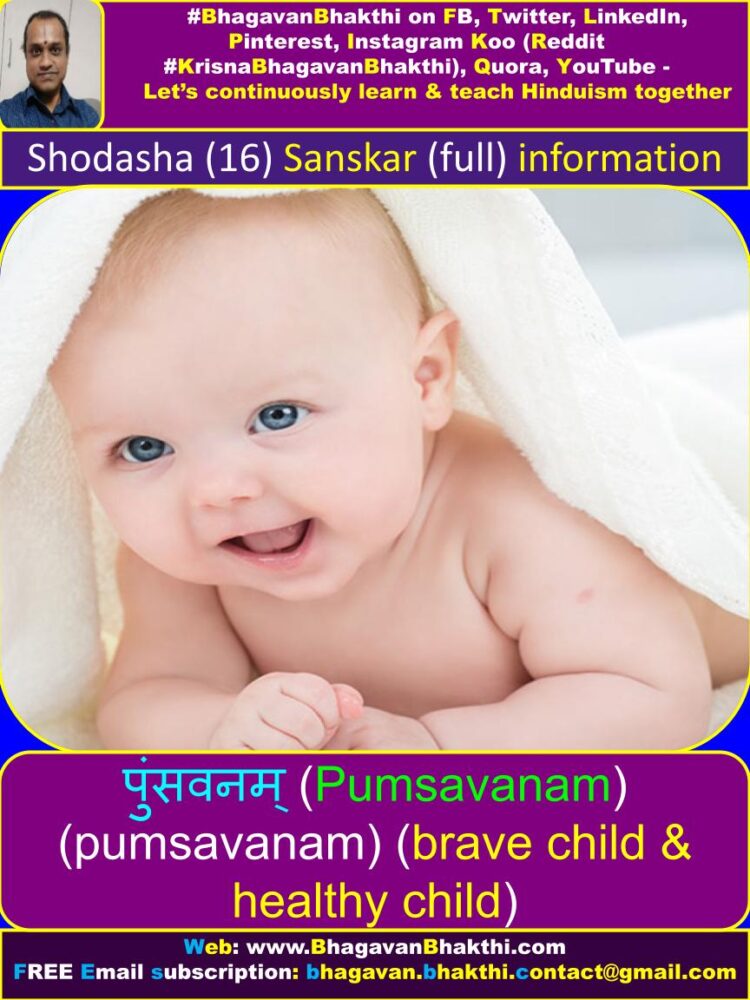
3. Seemantam : (सीमन्तम्) (sīmantam) or सीमन्तोनयनम् (Seemantonayanam) (sīmantōnayanam) – Tritiyam (Third) – (For having normal delivery)
This is the third of the sanskar practiced during the seventh month of pregnancy for having normal delivery of the baby.
In case the mother who is conceiving the baby has any stress, worries, negative feelings, anxiety etc. –
then Seemantonayanam gives mental and physical power to the maata / mother as well as the infant and help both of them to overcome any depressions, anxiety neurosis etc.
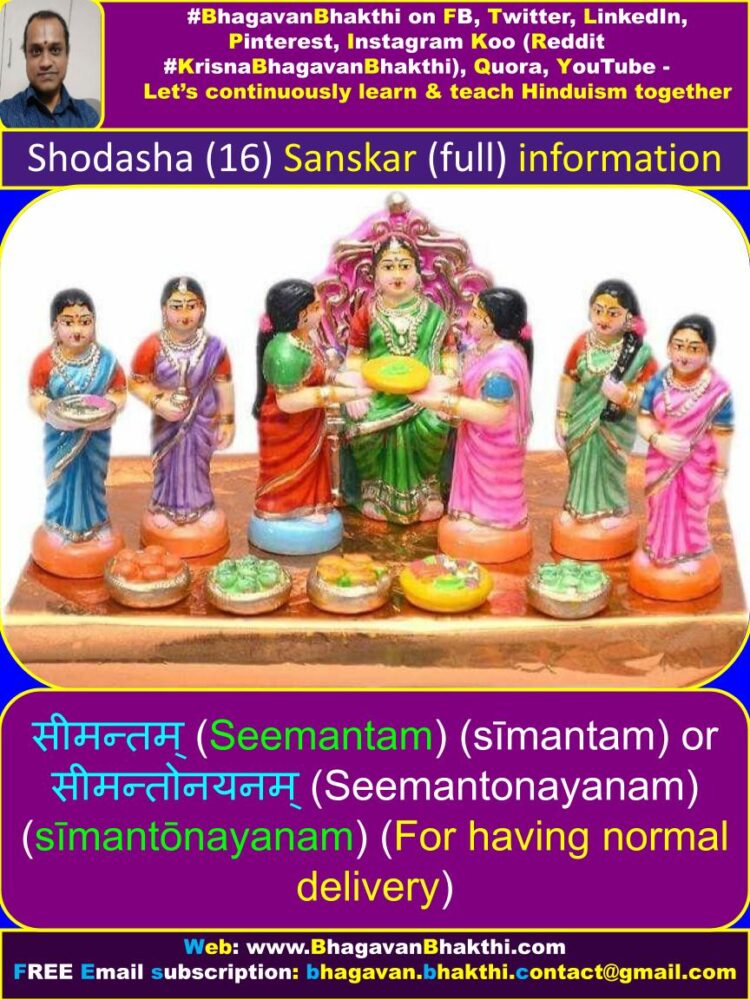
4. Jaatakarmam : (जातकर्मम्) (jātakarmam) – Chaturtam (Fourth) – (Birth ceremony)
The fourth line of sanskar is Jaatakarma done after baby take birth. This sanskar is of very much importance, as this great Jaatakarma sanskar enhances the baby’s growth.
Here jaataka means jaataka (horoscope) and karma means writing the jaataka of the baby which is born.
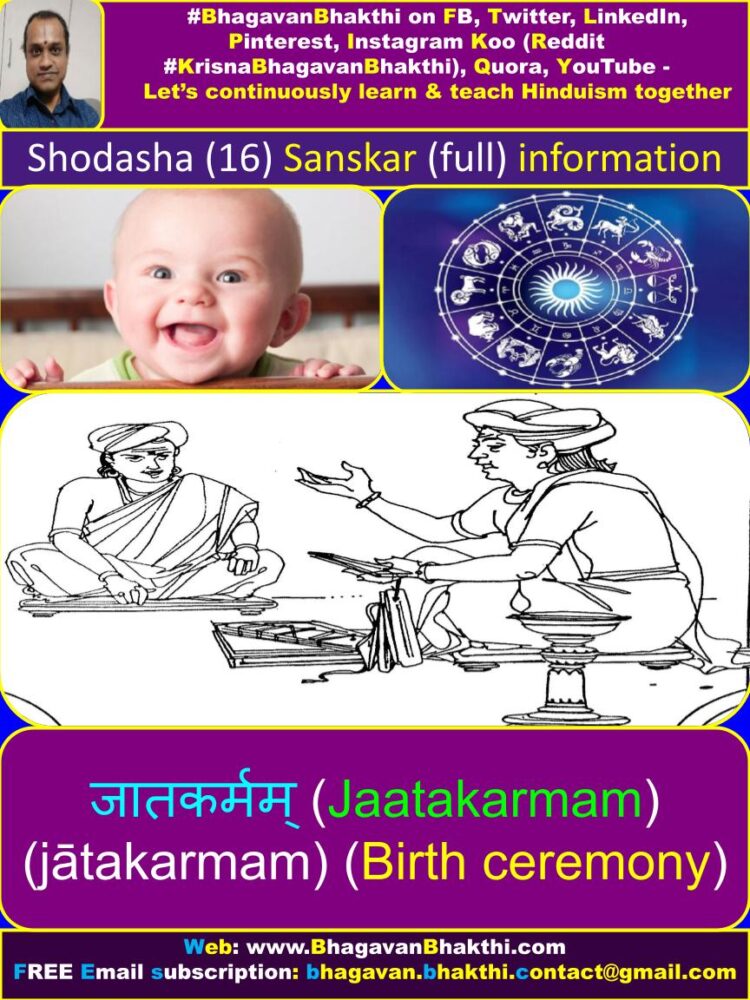
5. Naamakarana : (नामकरणम्) (nāmakaraṇam) – Panchamam (Fifth) – (Naming ceremony)
This is the fifth line of sanskar. Here the elders decide the name of the baby for his / her identity. Baby is then placed in the dolika / paalna / cradle with a prayer, seeking blessings for the baby.

6. Nishkramanam : (निष्क्रमणम्) (niṣkramaṇam) – Shat (Sixth)
Taking a child for the first time out of the house in the fourth month after birth to see the sun.
This is the sixth line of sanskar. Here elders introduce the baby to the external world (that means the baby is shown the external surrounding for the first time in his / her life).
The child is first shown natural things like Sun, Moon, stars etc.
Also if possible, baby is taken to nearest temple to get the blessings of Lord Sri Hari (Vishnu) and other Devatas (Demigods).

7. Annaprashanam : (अन्नप्राशनम्) (annaprāśanam) – Saptamam (Seventh) – (Feeding rice food)
This is the seventh line of sanskar wherein the baby if fed with rice food for the first time. Food should be fed with the help of svarna / golden or rajata / silver spoon.
On this day, for the first time naivedya / bhog (naivedya shown food for Lord Sri Hari / Vishnu) anna will be given to the baby.

8. Karnavedha : (कर्णवेध) (karṇavēdha) – Ashtamam (Eighth) – (Piercing the ears)
Piercing the ears to receive ear-rings (ear-boring). This is usually performed in the sixth or seventh month after birth. In this sanskar piercing of the baby’s ear are done.
This is done so that the earrings can be worn by the baby. Here Karnavedha = karna means ear.
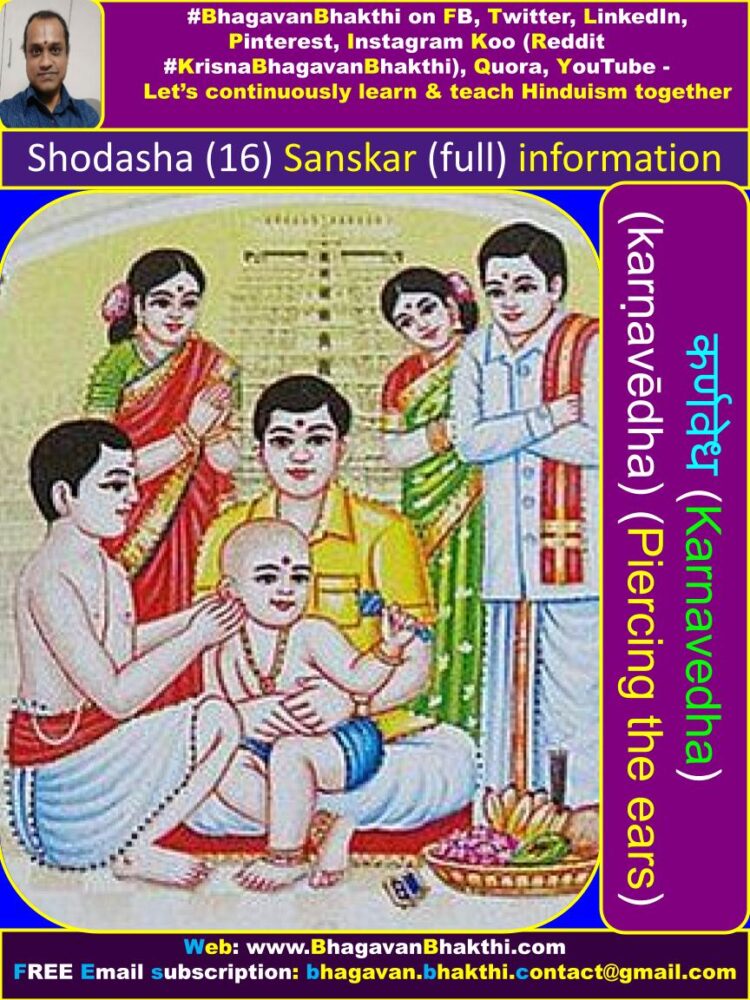
9. Choodakarmam : (चूडाकर्मम्) (cūḍākarmam) – Navamam (Ninth) – (Ceremony of tonsure)
This is the eighth line of sanskar. Here hair of the baby is shaved off for the first time.
Usually this is done when the male child is in the 3rd year and this is a very important and big ceremony for all the Hindus.
Few people have the tradition of giving the first hair at places of their choices in the very first year itself.

10. Aksharabhyaasa : (अक्षराभ्यासम्) (akṣarābhyāsaṁ) – Dashamam (Tenth) – (Teaching alphabets / letters)
This begins a child’s basic education by ceremonially introducing the child to the aksharas / alphabets.
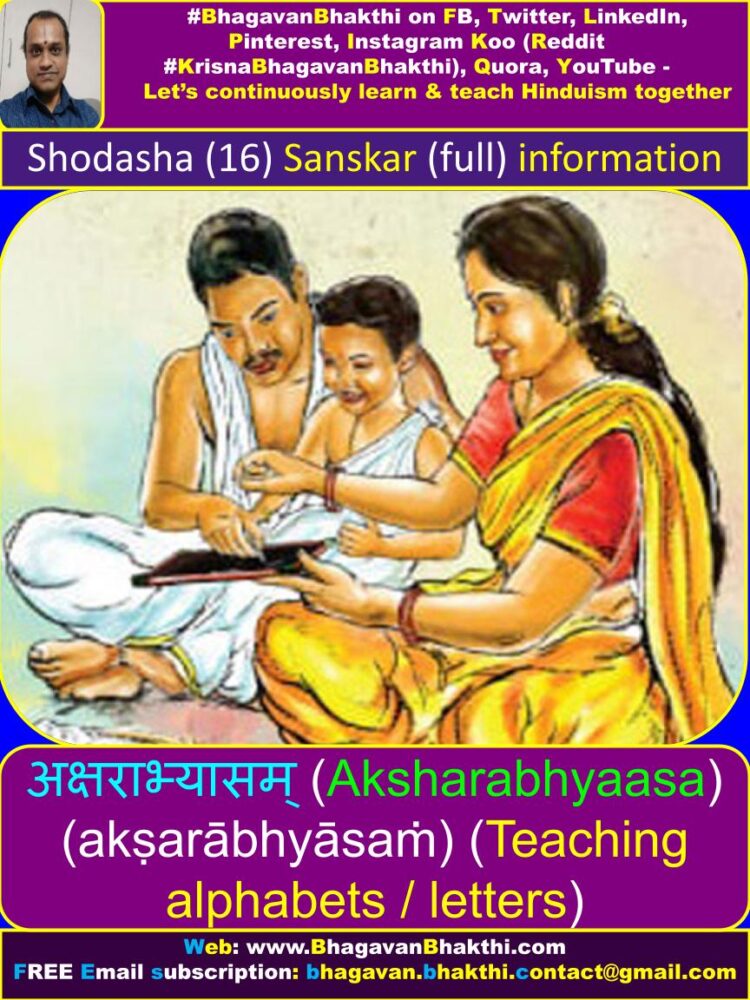
11. Upanayanam : (उपनयनम्) (upanayanam) Ekadashyaam (Eleventh) – (Janeu / Janivara / Yagnopaveetham / divine thread Ceremony)
Ninth line of sanskar marks the beginning of “Gurukula Vrata” and ‘Bhramacharya vrata’ in a child’s life.
This very important sanskar is performed to purify the body and ātma / soul of the child and it is useful in grasping power and the intellect of the child.
During this very important sanskar the child pledges to live life in a particular way (as instructed by Guru) and adhere to all kinds of hardships without any complaints.
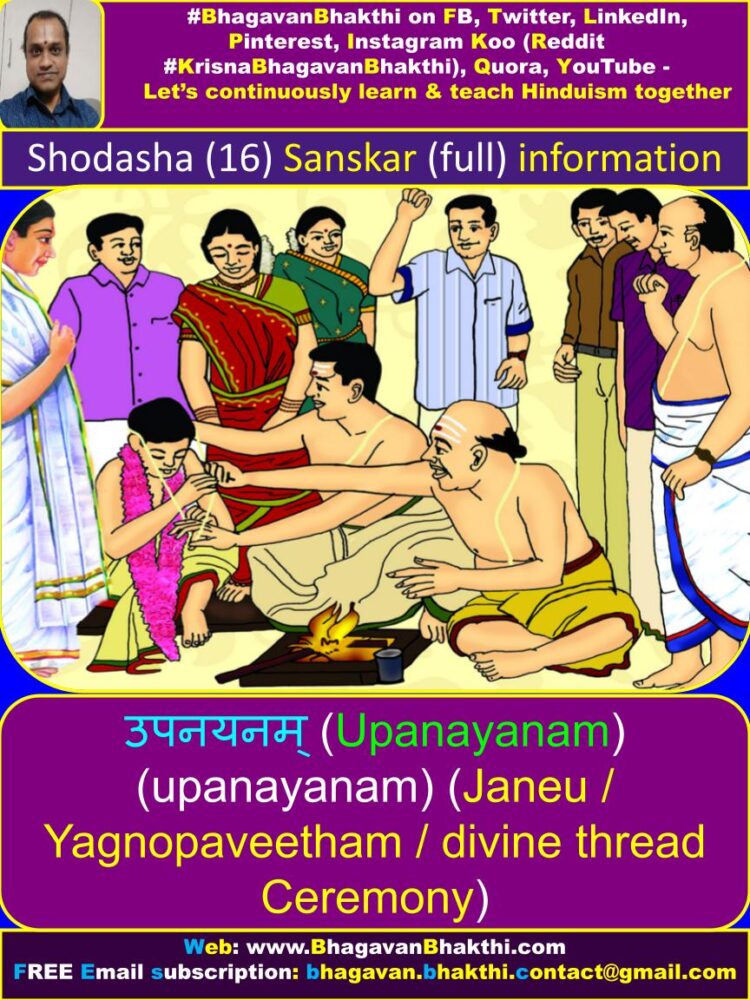
12. Samaavartanam : (समावर्तनम्) (samāvartanam) – Dwadashyaam (Twelfth)
Returning home after completing education. This is the dvadasha / twelfth sanskar that ends the ‘Bhramacharya’ of a child and the student / child is free from all his pledge undertaken during Upanayana.
By this time the child would had grownup and has to choose his way towards life amongst ‘pravriti’ (moving towards married life) and Nivruti (Sanyaasa).
Once he decides his way towards leading his own life by his own choice, now he seeks Guru’s permission for his choice of life and is accordingly blessed by his Guru.
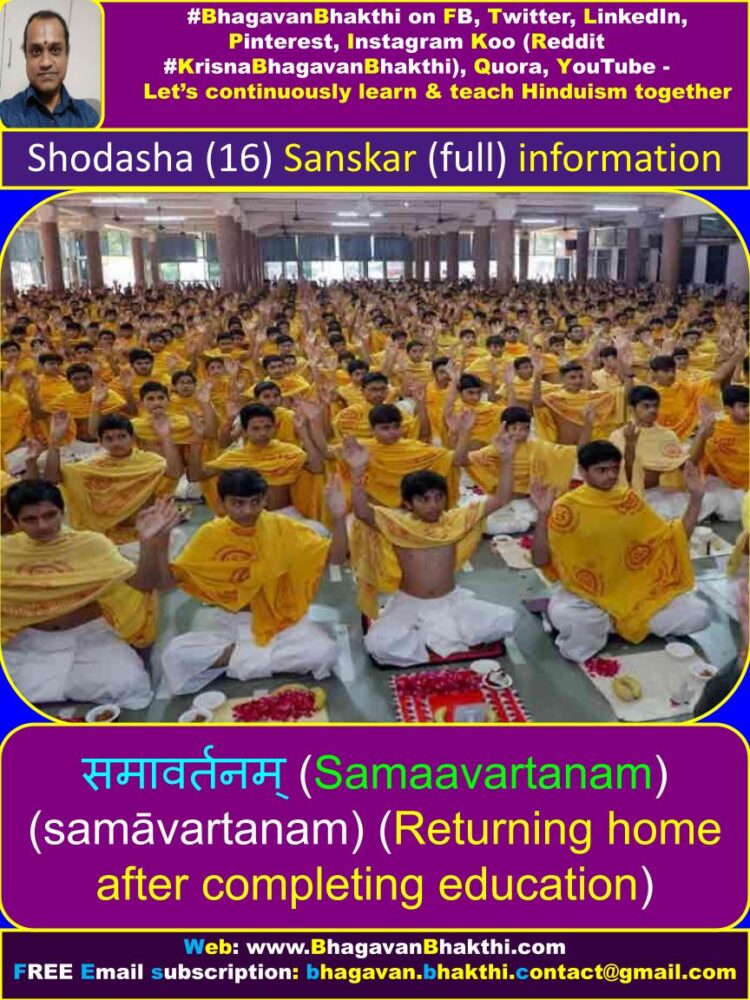
13. Pancha-Maha-Yagnam : (पंच-महा-यज्ञम्) (pan̄ca-mahā-yajñam) – Trayodashyaam (Thirteenth)
A dampati jodi / married couple performs the panchamahayajna (five great sacrifices) on daily basis.
In this sanskar, one honours all the Rishis (ancient Rushi-Munis of Sanatana Dharma Truth), the gods, the ancestors, humankind, and all created beings.
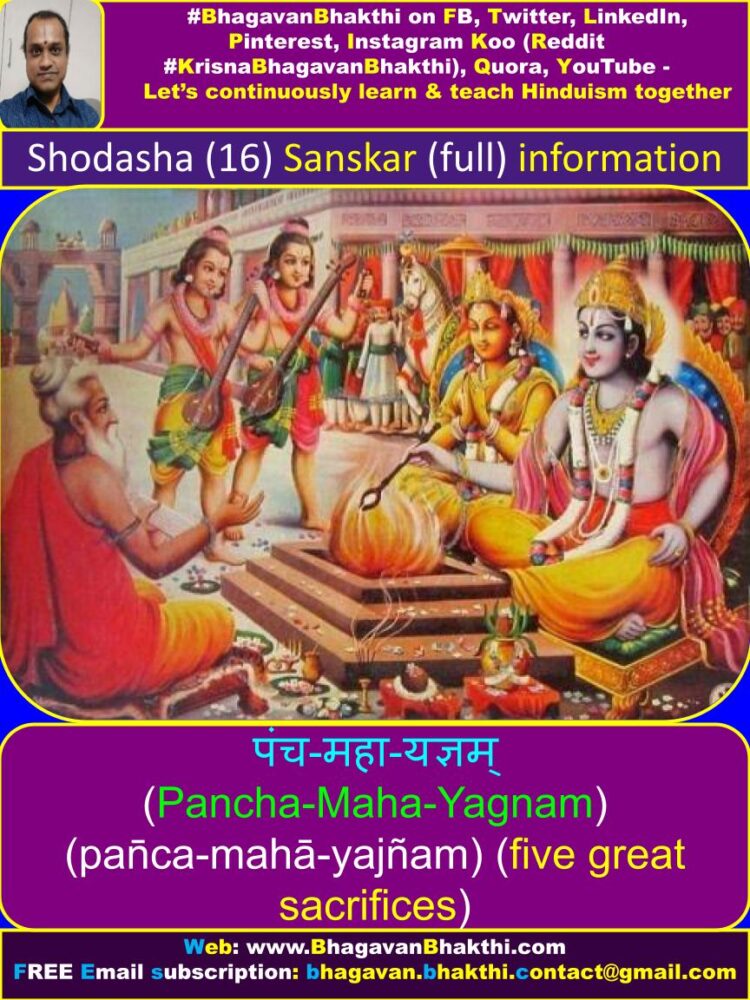
14. Vivaha sampradaayam : (विवाह-सम्प्रदायम्) (vivāha-sampradāyam) – Chaturdashyaam (Fourteenth) – (Marriage ceremony)
Vivaha sampradaayam (marriage ceremony) is the fourteenth sanskar. Here one decides to marry a kumaari / kumaara (girl / boy) of his/ her choice.
Vivaha sampradaya (marriage ceremony) is always one of the biggest ceremony in Bharateeya sampradaaya.
Sometimes customs vary compared with the places.
In Bhaarata, traditionally vivaha sampradaya / marriage ceremony takes place in presence of the entire family, relative, friends along with the special Yagnas.
The vara / groom and the vadhu / bride pledge to be honest and loyal to each other for the life term.
The mantras that is chanted during the vivaha sampradaya / marriage ceremony influence ones marital life and enhances their mutual love for the life term.
Mantras are also greatly useful for the married couple. These mantras showers all the pleasures and also brings prosperity to them throughout the life term.
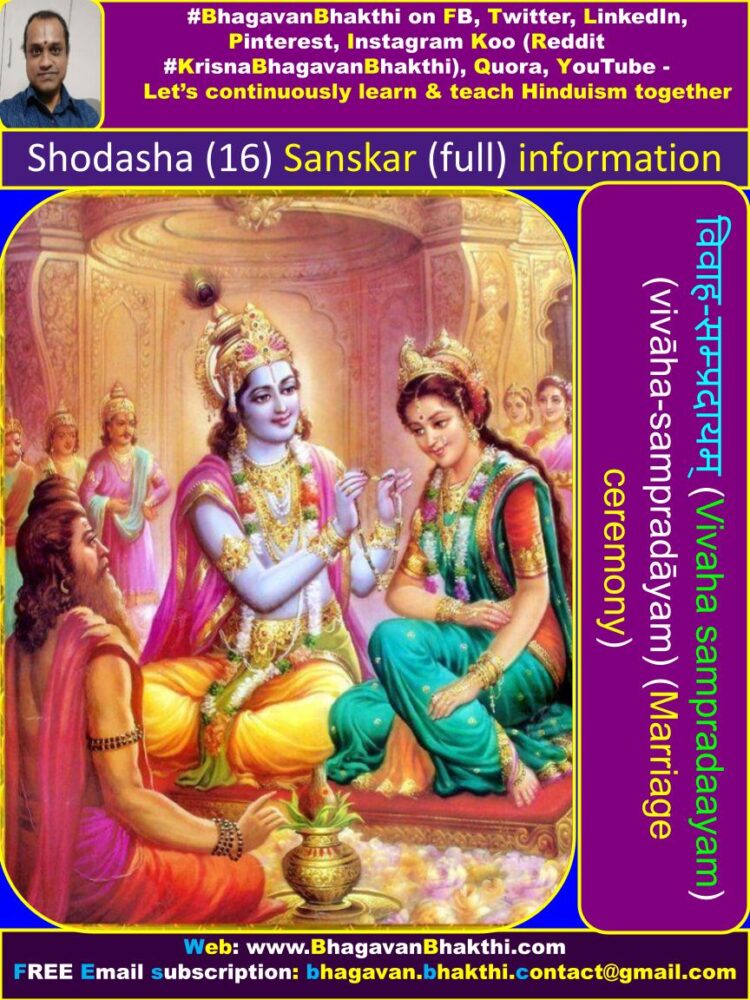
15. Vanaprastham : (वानप्रस्थम्) (vānaprastham) – Panchadashyaam (Fifteenth)
Man (with his wife) who has retired into forest to lead a secluded life of prayer.
In regards to the Great Sanatana Dharma Vedic sampradaya / tradition, vanaprastha is the third stage of life. This comes after Brahmacharya (Vedic student / disciple) and grihasta (family man).
In this sanskar a person leaves behind his life of the material world and retires to the forest (with or without his wife / husband).
This is done to live a tapasvi / ascetic life devoted to study of the Sanatana Dharma shaastras / scriptures and to meditate about Lord Sri Hari (Vishnu).
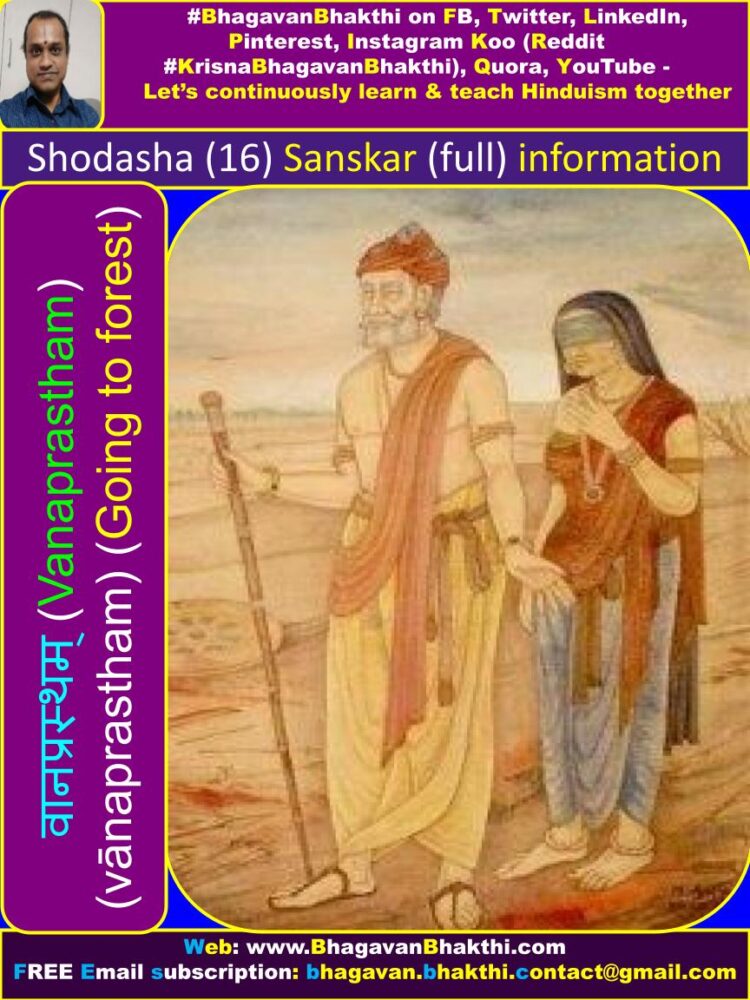
16. Antyeshti : (अन्त्येष्टि) (antyeṣṭi) – Shodashyaam (Sixteenth) – (Funeral ceremony)
The last sanskar is called anyteshti sanskar (antya sanskar) / funeral rites. This is done usually by the son. If son is not there, one of the closest relative performs this sanskar.

More information will be added to this on regular, please visit after some time to know more information.
To watch videos on #Hinduism #Sanskrit language, SUBSCRIBE to my YouTube channel from this below link:
#BhagavanBhakthi YouTube channel
To know more information about Hindu festivals details and significance, please click the below link:
Hindu festivals information, details and significance
Dear friends, if you need any clarifications about this post, kindly let me know, I will definitely try to answer all of them.
Also your one LIKE, one COMMENT, One Share, one SUBSCRIPTION is highly important.
This will help to know the quality of this content and also it will be helpful to know if any improvements is required for the content.
If you feel this content is useful to you and has helped you to improve your knowledge, kindly share this with your well-wishers.
Because “SHARING MEANS CARING”.
For receive FREE EMAIL SUBSCRIPTION about #BhagavanBhakthi, you can send an email to [email protected] from your email ID.
NAMASTE!
Sri Gurubhyo Namaha
Sri Krishnaaya Namaha
Sri Krishnaarpanamastu
Subscribe / Follow us Share in Social Media